
1 Widya Dharma University, Klaten, Central Java, Indonesia
2 Universitas 17 Agustus 1945 Semarang, Central Java, Indonesia
3 Politeknik Katolik Mangunwijaya, Semarang, Central Java, Indonesia
4 Universitas Nahdlatul Wathan, Mataram, West Nusa Tenggara, Indonesia
5 Universitas Hamzanwadi, Selong, West Nusa Tenggara, Indonesia
6 STIKES YARSI Mataram, West Nusa Tenggara, Indonesia
7 Universitas Krisnadwipayana, Jakarta, Indonesia
The transformation of rural communities on Lombok Island, West Nusa Tenggara (NTB, Indonesia) through education and tourism has made a significant contribution to improving the welfare of the local population. This research aims to explore what and how this transformation occurs. Lombok was chosen because it is included in the Super Priority Destinations (DSP) and the Indonesian Ministry of Tourism and Creative Economy has implemented a free Cleanliness, Health, Safety and Environment Sustainability (CHSE) certification program for the tourism industry in Lombok. Qualitative methodology was used in this research. Data were obtained through observation techniques, semi-structured interviews with the Deputy Governor of NTB, the head of the NTB regional research agency, and Focus Group Discussions (FGD) between MSME representatives and researchers in the Bilebante tourist village, Central Lombok. Qualitative data were analysed regarding community transformation related to education and tourism. Supporting data is taken from the Central Statistics Agency (BPS). Several informants were involved to explain how the involvement of education and tourism in the transformation process had a positive impact on their welfare. The results show that Lombok’s regional income (including education and tourism) has increased, where indicators of physical progress can be seen, namely modern Islamic boarding school education and Lombok tourism which is increasingly known to the world.
Transformation, society, education, tourism, Lombok
Introduction
Education and tourism are two elements that are closely related to achieving the prosperity of a nation. Through education, the quality of tourism human resources can be improved, and simultaneously welfare will increase along with the large number of tourists who come as a result of quality tourism human resources (Fitri, 2019; Pristiwasa, 2021; PBB, 2016). Education and tourism in Lombok, NTB, have undergone a transformation from a traditional atmosphere to a modern atmosphere. This study will discuss the transformation of rural communities in Lombok, NTB from the perspective of education and tourism launched by the NTB regional government. Previous research regarding the close relationship between education and tourism and the transformation of rural communities in Lombok has been carried out, including research by Padabain and Nugroho (2018) which examined the implementation of the Community Empowerment Tourism Village Program in Mas Village, Ubud Regency, Gianyar Regency, Bali Province. This research explores the transformation of education and tourism in Lombok, NTB.
A study of the role and relationship between tourism and education in improving the welfare of local communities shows that these two sectors support each other and can contribute significantly to sustainable development. Here are some international cases that illustrate how tourism and education work together to improve the welfare of local communities, namely in Bali Indonesia, Costa Rica, Bhutan and Kenya.
In terms of tourism, Bali is one of the most famous tourist destinations in the world. Tourism has become a major economic pillar, creating jobs and increasing the income of local communities. In terms of education, many schools and universities in Bali offer study programs that focus on tourism and hospitality (Clifton & Benson, 2006). For example, the Bali Tourism College provides special education in tourism management. Tourism-focused education helps create a skilled workforce that can meet the needs of the tourism industry. This improves the quality of services and tourist experiences, which in turn supports local economic growth. Training programs and short courses organised by educational institutions also provide opportunities for local residents to improve their skills, so as to compete in an increasingly competitive tourism labour market Krisna Balinese souvenirs, Sukawati Art Market, Joger Bali, Ubud Art Market, the Bali Basket offers a unique concept as a souvenir centre that combines the concept of souvenir shops, tourist attractions, restaurants, and training centres (Bali Tourism Board, 2023).
In terms of tourism, Costa Rica is known for its ecotourism, which utilises natural riches and biodiversity as the main attraction. In terms of education, universities in Costa Rica, such as the University of Costa Rica, offer study programs that focus on environmental conservation and ecotourism (Honey, 2008). Educational programs that emphasise the importance of environmental conservation help create awareness among local Costa Rican communities about the importance of preserving the natural environment for sustainable tourism. The involvement of local Costa Rican communities in ecotourism programs, supported by adequate education, helps create jobs that support the local economy without damaging the environment (University of Costa Rica, 2023).
Bhutan has adopted a tourism model based on high quality and low volume, with a focus on cultural and environmental preservation. Bhutan’s education system integrates lessons about the importance of preserving culture and the environment, in line with the country’s philosophy of Gross National Happiness (Royal Government of Bhutan, 2018). Education that promotes cultural and environmental preservation prepares local people to become tour guides who can provide authentic experiences to tourists, while maintaining the authenticity of Bhutan’s culture and environment (Ritchie & Crouch, 2003). Revenue from tourism is reinvested in the education system, strengthening the reciprocal relationship between these two sectors.
Tourism in Kenya relies heavily on safari tourism and biodiversity. Kenya Wildlife Service (KWS) and various educational institutions offer training programs for local communities in wildlife management and sustainable tourism. Training and education in wildlife management help local communities manage natural resources in a sustainable way, thereby supporting long-term tourism. Involvement of local communities in sustainable tourism through education increases community acceptance and support for conservation efforts, ultimately improving their economic well-being through tourism revenues (Akama & Kieti, 2007; KWS, 2023).
Literature Review
The case of tourism and education in Lombok needs to be analysed for four reasons: first, Lombok tourist destinations are developing rapidly. Lombok experienced significant growth in tourism, especially after the creation of the Mandalika Special Economic Zone, which aimed to improve tourism infrastructure and attract international visitors. Untapped Potential: In contrast to Bali, Lombok is still relatively underdeveloped, providing a unique opportunity to study the impact of tourism in the early stages of its development.
Second, socio-economic context, tourism can improve the local economy by creating jobs, increasing income, and encouraging small businesses. Understanding these impacts on Lombok can provide insight into how similar areas might develop. In terms of Education and Skills Development, assessing the role of education programs in equipping the local workforce with the skills needed in the tourism industry is very important. This can help design better education policies that suit economic needs.
Third, cultural and environmental considerations. Lombok offers a rich cultural and traditional experience. Analysing the impact of tourism on the preservation and promotion of local culture can provide valuable lessons for sustainable tourism practices. As a growing tourist destination, studying Lombok can help understand how tourism affects natural resources and what steps can reduce negative impacts, ensuring long-term sustainability.
Fourth, Comparative Analysis with Bali. While Bali is an established tourism hub, Lombok provides a contrast as a developing destination. Comparing the two can highlight different developmental stages and strategies that are successful or need improvement.
Fifth, Government Support and Policy: The Indonesian Government shows strong support for developing Lombok as a major tourist destination. Studying this area can reveal the effectiveness of government policy and its role in regional development.
Other scientific reasons can be studied from Law number 10 of 2009 article 4 which states that tourism aims to: increase economic growth; improving community welfare; eradicating poverty; overcoming unemployment; preserving nature, the environment and resources; promote culture; raising the nation’s image; foster a sense of love for the country; strengthening national identity and unity; and strengthening international friendship (Law No. 10 of 2009).
To realise this tourist destination, support from various facilities and services provided by the community, entrepreneurs, the Government and the Regional Government is needed. Lombok was chosen because it is included in the Super Priority Destinations (DSP) and the Indonesian Ministry of Tourism and Creative Economy has implemented a free Cleanliness, Health, Safety and Environment Sustainability (CHSE) certification program for the tourism industry in Lombok, NTB.
According to K. Krapt and Hunziker (in Yoeti, OK, 2008) tourism is a human activity carried out manually with the awareness that they receive services alternately between people in their own country/abroad, including the residence of people from other areas temporary. looking for satisfaction that is varied and different from what he experienced, where he got a permanent job. According to Meyers (2009), Tourism is the activity of travelling with the aim of obtaining enjoyment, seeking satisfaction, knowing something, improving health, enjoying exercise or rest, fulfilling duties, going on a pilgrimage and so on. Kane and Tucker (2004) define tourism as a trip that people undertake temporarily, from one place to another, leaving their place of origin, with a plan and with the intention of not trying or making a living. in different places visited, but solely for the pleasure of sightseeing and recreational activities or to fulfil various desires (Akib, 2020; Sunaryo et al., 2022).
Developing tourism in Lombok requires community empowerment. Padabain and Nugroho (2018) stated that community empowerment aims to create an independent and prosperous society, able to explore and utilise the potential that exists in their respective regions and help communities to be free from backwardness or poverty. Therefore, Lombok, with its people’s ability to utilise natural and cultural resources, has the potential to build economic acceleration, which is now starting to be seen in several sectors (Padabain & Nugroho, 2018).
An indicator of the success of tourism development in Lombok can be seen from the relocation of rural communities who are still in harmony with residents who have become part of the modernity of Lombok Island, giving rise to a sense of satisfaction (Akib, 2020). Community satisfaction is achieved through social interactions that strengthen social culture, not property/comfort consumption. Developing rural-regional marketing strategies that can better articulate the sociocultural dimensions of communities can increase awareness of place-based values/characteristics prior to relocation to avoid conformity and costs to poor communities (Ragusa, 2022).
Tourism is a variety of tourist activities supported by various facilities and services provided by the community, entrepreneurs, government and local governments. In Indonesia, tourism aims to: increase economic growth; improving community welfare; eradicating poverty; overcoming unemployment; preserving nature, the environment and resources; promote culture; raising the nation’s image; foster a sense of love for the country; strengthening national identity and unity; and strengthen friendship between nations (Republic of Indonesia Tourism Law, 2009). The function of tourism development is emphasised for the welfare of the Indonesian people, including rural communities on the island of Lombok, NTB (Akib, 2020).
Lombok is one of the islands which is separated by Lombok Strait from Bali next to the West and Alas Strait East of Sumbawa. This island is round with a kind of ‘tail’ on the side, Southwest, which is approximately 70 km long. The island’s area of 5,435 km² places it in 108th place list of islands by region in the world. Lombok was chosen in this research because it has many unique things in terms of nature, culture, various foods and many others. However, what has been talked about most recently is the natural beauty of Lombok Island. Starting from Senggigi Beach, Malimbu Beach, Sekotong Beach, Kuta Beach, Central Lombok, Sendang Gile Waterfall, Tiu Kelep Waterfall and many more beautiful things on Lombok Island. It is not surprising that many tourists, both foreign and domestic, come through Lombok International Airport (picture 4) to spend time together enjoying the natural beauty of Lombok Island (Rimbakita, 2022; Tempo, 2018; Wulandari, 2021). Figure 6 shows the Lombok International Airport where researchers and tourists enter Lombok Island.
Figure 1 shows the beautiful island of Lombok seen from the coast with fishing boats and also for tourists who come who want to witness the beauty of Lombok Island directly from close range. Lombok Strait marks the boundaries plant and fauna of Asia. Starting from Lombok Island to the east, the flora and fauna show more similarities to the flora and fauna found in Indonesia and Australia than in Asia. The scientist who first stated this was Alfred Russell Wallace, an English citizen in the 19th century. From 1854 to 1862, this British researcher travelled around Indonesia to collect biological specimens (Nailufar, 2020; Rimbakita, 2022). In honour of him, this boundary is called the Wallace Line.
Figure 1. Lombok Island.

Source: https://en.wikipedia.org/wiki/Lombok.
Figure 2 shows the Wallace Line, an imaginary line that separates Central Indonesia (including Lombok) and Eastern Indonesia. This line was created because there are differences in the characteristics of flora and fauna in the area. This line is named after its discoverer, Alfred Russel Wallace.
Figure 2. Wallace Line.
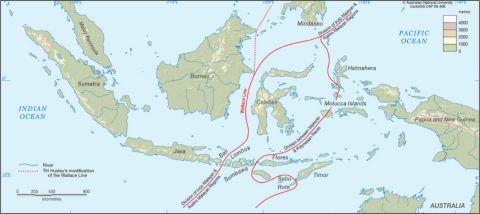
Source: Prakoso (2025).
The line stretches across Southeast Asia, across the narrow waters between Borneo and Sulawesi and between Bali and Lombok. While not an official border, the Wallace Line acts as a natural barrier for many animals, demonstrating how physical barriers can divide habitats even if they are close together.
The Wallace Line plays a significant role in the evolution of species. The striking differences between the fauna on either side of the line inspired Alfred Russel Wallace to develop the theory of evolution with Charles Darwin. Wallace observed that species do not arise randomly, but evolve according to their environment. (Source:https://www.tempo.co/sains/mengenal-garis-wallace-batas-alam-yang-tidak-dilewati-spesies-apa-pun-1209846) The topography of Lombok Island is dominated by the beautiful volcano Rinjani, which reaches 3,726 meters above sea level and makes it the third highest in Indonesia. This volcano last erupted in June-July 1994. In the year of 1997, the mountainous area and the Segara Anak lake in the middle were declared protected by the government. The southern region of the island of Lombok mostly consists of fertile land used for agricultural commodities commonly grown in this region include corn, paddy, coffee, tobacco and cotton.
The people of Lombok are also known to have high tolerance. The harmonious combination of tourism and religion made Lombok awarded as the World’s Best Halal and the World’s Best Halal Honeymoon 2015 in Dubai, United Arab Emirates.
Lombok Island is included in the Lesser Sunda Islands. The small islands that surround Lombok Island are called Gili. There are three Gilis which are tourist favourites for snorkelling, diving and fishing activities, including Gili Trawangan, Gili Air and Gili Meno. Not only these three dykes, other dykes in the archipelago also have very beautiful charm. As an island community, the people of Lombok are not yet familiar with organisational culture (Hermawan & Loo, 2019; Irawanto et al., 2011a, 2011b; Selvarajah & Meyer, 2017; Selvarajah et al., 2016). There are strong indications that cultural norms in Lombok’s legacy of social interaction are the ‘soul’ of modern business. This requires transformation. The problem is, what is the picture and form of community transformation on Lombok Island through education and tourism? Has this transformation succeeded in making the people of Lombok better and more prosperous?
Method
Qualitative research methods (Creswell, 2012; Ismawati, 2016; Sosa-Díaz & Valverde-Berrocoso, 2022) used in this research included observation, semi-structured interviews and focus group discussions (FGD). The qualitative research approach in this study uses in-depth interviews: namely, conducting interviews with key stakeholders such as deputy governors, tourism managers, school teachers, lecturers and local communities to gain an in-depth view of the impact of tourism and education in Lombok on the local economy. FGD, namely holding FGDs with various stakeholders to understand the dynamics and perceptions regarding the role of tourism and education in the local economy, was held at the house of the deputy governor, at Mataram University, at Nahdatul Wathan University, at Hamzanwadi University, at the NTB regional research office, at the industry office, and at the NTB Language office. Figure 7 shows the campus of Mataram University where researchers held an FGD with the rector and lecturers regarding education and tourism on Lombok Island.
In-depth observations were also carried out when researchers were in Lombok during the 2022 holidays so that they could produce a more comprehensive study on education. and tourism in Lombok. Semi-structured interviews were conducted at the official residence of the deputy governor of NTB with sources from the deputy governor of NTB and the head of the NTB regional research service.
In this study, the research team came from 17 universities (Suara NTB, 2022) from Lombok Island and from outside Lombok Island and had to travel by land or air to make observations. Several observation models were used in this research. Participatory observation is a data collection method used to collect research data through observation and sensing, where researchers are involved in the daily lives of informants. Also, unstructured observations, namely observations carried out without using observation guidelines, so that researchers develop their observations based on developments that occur in the field. Group observation is an observation carried out by a research team on a problem that is the object of research.
The final method used to collect data is through FGD, which is an effort to find the meaning of a problem by a group of researchers through discussion, so that there are no misunderstandings by the researcher. FGDs were held at Mataram University, Nahdlatul Wathan Mataram University, and Hamzanwadi University.
The names of universities that participate in research and community service on the island of Lombok provided in Table 1. They consist of 17 universities from various regions in Indonesia. Apart from the research team from 17 universities, this research also involved several informants, including: informant from East Lombok Regency High School Supervisor, informant from Nahdlatul Wathan Anjani High School Teacher, informant from Benteng Vocational School Teacher, informant from East Lombok State 1 Madrasah Aliyah Teacher, informant from State 2 Elementary School Teacher, informant from Selong Model State Madrasah Tsanawiyah Teacher, Head informant Madrasah Aliyah Negeri 1 East Lombok, informant, Religion Teacher at SD Negeri 5 Pringgajurang. Also, resource persons from the Deputy Governor of NTB and the NTB Provincial Government Team who were present at the official residence of the Deputy Governor of NTB, namely the Head of the Tourism Service, the Head of the Regional Research Agency, and the Director of the Bilebante Tourism Village, as well as the Head of Bilebante Village, Central Lombok, NTB.
Table 1. Research Team from Indonesian Universities Who Came to Lombok.
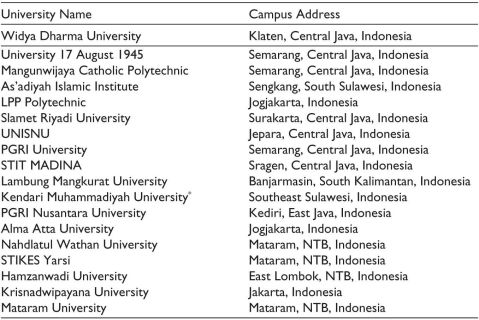
Note: *Absent.
Implementation of Interviews and FGDs
The methodological details regarding what exactly was done and how exactly the method was applied are as follows. First, we submitted a proposal to the NTB Deputy Governor that we, from 17 universities in Indonesia, would hold an academic gathering in the NTB province to see firsthand the transformation of potential tourist destinations through improving the education system and the progress of tourism development in NTB and its impact on the community through direct interviews. Figure 3 shows FGD participants who came from 17 universities in Indonesia. They took a photo with the Deputy Governor of NTB, Mrs Siti Rohmi D (in white in the middle of the front row) at the official residence of the deputy governor of NTB. The NTB Deputy Governor responded to our proposal and expressed her willingness to receive us at the NTB Deputy Governor’s official residence (photo attached). In this agreement, the NTB Deputy Governor, together with the head of the tourism office, the head of the NTB regional research agency, the head of the statistics office, and other related officials, received us in an FGD at the NTB Deputy Governor’s official residence. The NTB Deputy Governor and NTB officials invited by the NTB Deputy Governor acted as resource persons, and we, representatives from 17 universities, acted as questioners. It so happened that the NTB Deputy Governor was our friend when we were studying for our master’s at the Surabaya Institute of Technology. From the Deputy Governor’s official residence, we continued with field observations.
Figure 3. FGD participants at the NTB Deputy Governor’s Office.

Our first observation was conducted in the traditional village of the Sasak tribe, the observation was conducted by interviewing UMKM actors regarding the progress of the tourism sector, especially by seeing the many Sasak Tribe people who are looking for additional income by making various souvenirs, not only woven fabrics, but also various culinary delights and the many home stays and productive tourist villages. The interview results were validated with statistical data presented in the research results section. Figure 4 shows a traditional Sasak house in Lombok where researchers obtained typical Sasak souvenirs in the form of woven cloth and various wooden souvenirs made by local residents.
Figure 4. Sasak Tribe Tourist Village.
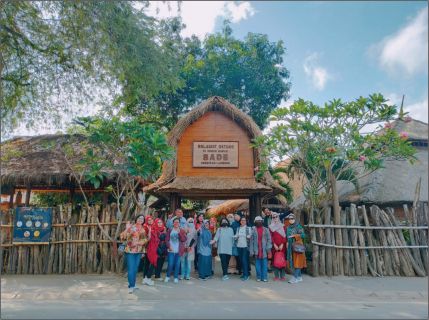
The composition and number of Focus Group Interviews conducted with details of the questions asked are as follows: interviews regarding Education transformation were conducted with the head of the regional research agency, and continued with FGD at Mataram University led by the rector of Mataram University, continued with FGD at Hamzanwadi University led by the vice rector for academic affairs, and FGD at Nahdlatul Wathan University, Mataram, led by the vice rector for academic affairs. So that FGDs were conducted four times, namely at the official residence of the NTB deputy governor and at the three universities mentioned above. The FGD also discussed Secondary Macroeconomic Data, taken from various sources, which were requested by FGD participants.
Results and Discussion
Transformation in Education
From the informants, it is known that there has been a transformation of education in Lombok, from Islamic boarding school-style education to modern education. From the informants, it is known that the people of Lombok are known as a religious society, so that the education system in Lombok is known as Islamic boarding school education, which has transformed into a modern Islamic boarding school with learning English and Arabic as international languages. A well-known and respected figure in the world of Lombok education is Tuan Guru Kyai Haji (TGKH) Muhammad Zainuddin Abdul Madjid (Noor et al., 2014). Another name is HAMZANWADI which is an abbreviation of Haji Muhammad Zainuddin Abdul Madjid Nahdlatul Wathan Diniyah Islamiah because he founded the Nahdlatul Wathan school as a forum for struggle with three focuses of struggle, namely the fields of da’wah, social and education.
The field of da’wah is realised in the form of lectures (recitations) which are carried out from one village to another, from one mosque to another (Hamdi, 2018; Noor et al., 2014). Struggle in the social and educational fields is manifested in the form of formal and non-formal institutions. Social sector institutions that are still standing strong and running today are the Darul Arkam NW Pancor Orphanage and several other orphanages spread across several villages, as well as educational institutions that are widely spread from kindergartens to universities. The parent educational institution, which is the focus of the struggle in the education sector, is named NWDI (Asyári et al., 2015).
Establishing educational institutions at a time when society was still colonised and some ulama only focused on guiding their congregation, HAMZANWADI realised that only through educational institutions (madrasas) would the output be more effective, systematic and measurable so that they could compete on the global stage. market (Hamdi, 2018). This is a real transformation in the field of education.
The spirit of building a generation through education has been Hamzanwadi’s commitment from the start, that all his students must be able to prepare themselves by mastering knowledge in all fields in order to become human beings who are able to compete in the future. This can be seen from the message contained in the mass reflection testament in stanza 115 (Hamzanwadi, 1998). The spirit of becoming people who are able to compete in the future inspires residents on Lombok Island and NTB Province, which in 2022 will have a total of 5,800 students. Details can be seen in Table 2.
Table 2. Percentage of Male and Female Population Aged 7–24 Years by Regency/City and Education Status, 2022.

Source: Susenas, March 2022. (https://silastik.bps.go.id/v3/index.php/mikrodata/detail/VTJ5WXltN2hQZE9KWDFKOGNPdTFXZz09)
The educational transformation that occurred in Lombok was a change in the traditional Islamic boarding school education model to a modern Islamic boarding school by adding the study of cultural aspects, tourism and English and Arabic to communication practices in Islamic boarding schools, so that it also had a positive impact. the influence on economic growth with the large number of students who come from various corners of Indonesia, Malaysia, Brunei, etc.
Meanwhile, economic growth data shows that the economy of West Nusa Tenggara in the first quarter of 2023, compared to the first quarter of 2022, grew by 3.57%. In terms of production, Construction experienced the highest growth of 12.76%. In terms of expenditure, the PMTB component experienced the highest growth of 6.21% (BPS, 2023). From the results of interviews with the deputy governor of NTB, it is known that the economy of West Nusa Tenggara in the first quarter of 2023, compared to the previous quarter, experienced a contraction of 2.37% (q-to-q). From the production side, the Processing Industry Business Field experienced the deepest contraction of 15.23%. Meanwhile, in terms of expenditure, the Export of Goods and Services component experienced the highest contraction of 20.17% (BPS, 2023).
Gross regional domestic product in Table 3 above is the total gross value added arising from the entire economy in Lombok and West Nusa Tenggara. Calculating gross regional domestic product aims to assist NTB policymaking or evaluate development results, which can provide information regarding the economic performance of Lombok and NTB.
Table 3. NTB Gross Regional Domestic Product (GRDP) 2021–2022.
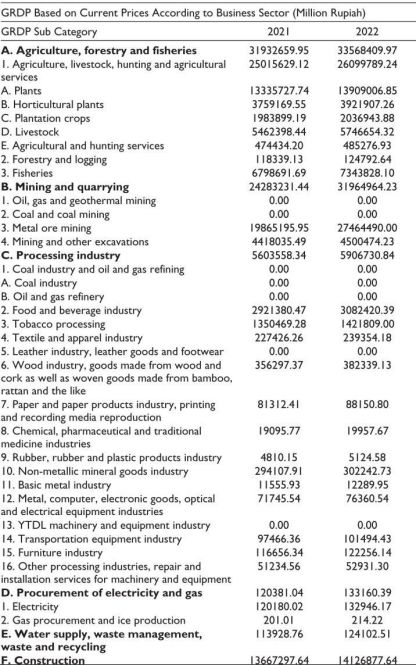
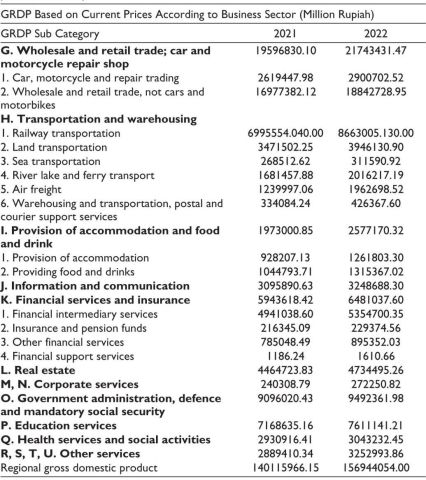
Source: Badan Pusat Statistik Provinsi Nusa Tenggara Barat (2023).
From Table 3 above, it can be seen that NTB’s Gross Domestic Product has increased significantly, which shows that economic conditions are getting better. Improvements related to tourism include points H and I, namely H. Transportation and Warehousing, which includes:
I. Provision of accommodation and food and drink, which includes:
The Uniqueness of Educational Transformation in Lombok
Table 4 shows the names of Islamic boarding schools in Lombok that have transformed from a traditional education model to a modern education model. Education in Lombok is Islamic boarding school-based and the majority is managed by the Islamic Foundation. Objective: To perfect the sentence of Allah Izzul Islam wal Muslimin and happiness in the world and the hereafter. Efforts made to achieve these goals, which are also stated in the AD are: (a) Improving mutt: education and culture in accordance with Islamic teachings. (b) Establishing madrasas/schools, student dormitories, places of worship and health centres. (c) Broadcasting the Islamic religion through tabligh-tablig, recitations, publications and other da’wah media. (d) Turn on a fertile soul, ask for help, increase social charity and charity. (e) Organising courses, libraries and reading parks. (f) Maintaining Islamic brotherhood and community peace. (g) Cooperate with other groups.
Table 4. Transforming Islamic Boarding Schools in Lombok.

Based on the results of observations and interviews conducted with education supervisors, teachers and school principals, information can be obtained about the transformation of Islamic boarding school education into modern education with santri culture on Lombok Island at the basic education level. socio-cultural values. A manifestation of the transformation of Islamic boarding school education on Lombok Island into modern education is the pattern of moral education, namely, elementary school students are taught the tak’lim muta’alim method (how to learn and teach). Students are taught how to have good morals by teachers in order to obtain knowledge that is blessed (useful). The form of ethics that is instilled is that students are taught to greet and kiss the teacher’s hand when they come to school.
In the socio-cultural field, the transformation of Islamic boarding school education can be seen in the way they dress. Schools require students to dress like santri when they come to school on certain days, for example, on Fridays and religious holidays organised by the school. Students are required to wear Muslim clothing, it has even been made into a mandatory uniform to wear on certain days. Clothing is the most striking attribute as evidence of the transformation of Islamic boarding school education into modern education with a santri culture.
The transformation of Islamic boarding school education into modern education with santri culture at the middle and high school levels is often found in schools under the auspices of the Ministry of Religion, although it is also reflected in state schools under the auspices of the Ministry of Education and Culture. Islamic boarding school education, which has undergone a transformation into modern education at the junior and senior secondary education levels, is not much different from the basic education level, however, the style of Islamic boarding school education is more prominent when compared to elementary schools. The transformation of Islamic boarding school education is not only in the field of moral development, the practice of religious teachings, but also in the field of curriculum, which is outlined in extracurricular activities with the addition of ecotourism studies.
Apart from that, the Islamic boarding school education pattern that is developing in modern santri-based schools on Lombok Island is very closely related to tourism organisations, so that the Islamic boarding school education pattern that is developing in schools on Lombok Island is an ecotourism-based Islamic boarding school that prepares its students to become skilled tourist guides (Kementerian Agama Republik Indonesia, 2020).
There are also universities that open tourism departments, namely the College of Tourism and Muhammadiyah University of Mataram, which are open to all sons of the Indonesian nation. In general, private educational institutions located throughout West Nusa Tenggara have religious and national motivations with the aim of overcoming the difficulties of children who are not accommodated in state schools due to difficulties in educational facilities and infrastructure. and assist the Government in efforts to make the nation’s life smarter through tourism skills. One of the private universities in Mataram that is developing is Nahdhatul Wathan University, with a total of 7,000 students in 2022, which is also opening tourism studies in the LPPM.
Transformation in Tourism
Realising the tourism potential of Lombok Island, the local government is collaborating with various parties, especially universities, to launch a work program in the tourism sector by adding several typical Lombok icons (Sunaryo et al., 2022).
Universities are centres of information and learning for students and the community in Lombok. Universities also play an important role in solving various problems that arise in society, including tourism problems. Education for Sustainable Development is a learning method for solving community problems through formal, informal and non-formal education with additional information about tourism in Lombok. This program aims to change the orientation of education and learning so that every individual has the same opportunity to acquire knowledge, skills, values, attitudes and behaviour that can strengthen themselves in contributing to sustainable development, especially regarding tourism development in Lombok. Figure 8 shows a traditional house of the Sasak tribe in Lombok. The researchers are wearing traditional Sasak clothes.
Figure 5. Nahdlatul Wathan University Mataram (Photo by Researcher).
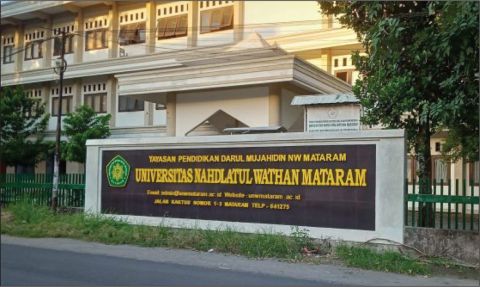
Figure 6. Icons at Lombok International Airport.
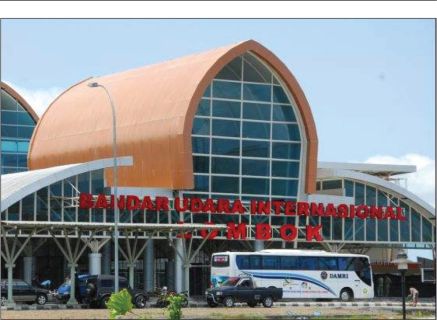
Source: Lombok Island (2012).
Figure 7. FGD Participants at the University of Mataram.
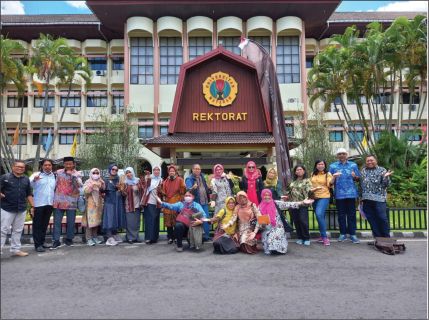
Figure 8. Sasak Tribe Traditional House in Lombok and Today’s Tourists (Photo by Researcher).
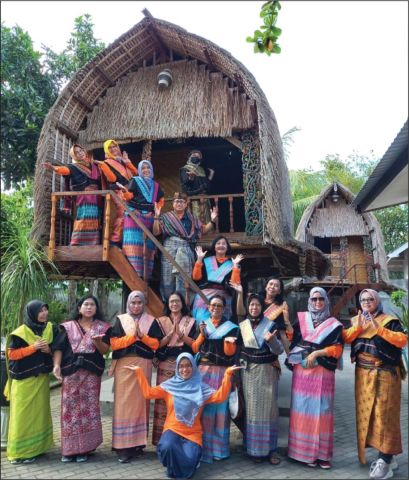
One form of learning for the community carried out by universities in Lombok is by providing various life skills training to women’s tourism organisations in Lombok, for example, typical Lombok weaving as souvenirs. Providing important training to solve various problems faced by women and men in Lombok society in the fields of education, agriculture, health and tourism, for example, in making souvenirs for tourists, making typical Lombok food as souvenirs for tourists.
The dynamics of higher education on the island of Lombok show tremendous enthusiasm among the younger generation, as has been researched by Garci (2022) in Central America and Binder et al. (2022) in Australia on the Experiences and Expectations of the Young Generation from Poor Environments (Garci, 2022). In Lombok, the younger generation also contributed great enthusiasm (interviews with lecturers from Hamzanwadi University and Nahdlatul Wathan and their students), showing that they are enthusiastic about rising and transforming towards a modern and religious society through tourism. Figure 5 shows the Nahdlatul Wathan Mataram University campus where the researcher held an FGD with the vice chancellor and lecturers.
Several Lombok tourism achievements have received international and national recognition. Kembang Kuning Tourism Village, East Lombok, won first place in the 2019 Archipelago Tourism Village Competition held by the Ministry of Tourism and the Ministry of Development of Disadvantaged Regions of the Republic of Indonesia and received a CHSE Certificate (Cleanliness, Health, Environmental Safety). Then, the tourist village of Sesaot, West Lombok district, received the 2019 Indonesia Sustainable Tourism Award in the environmental sector from the Ministry of Tourism and Creative Economy.
Also, the 2021 Sustainable Tourism Village Award and Certification with Bilebante Village, Central Lombok and Kembang Kuning Tourism Village, East Lombok. Not to forget, Tetebatu Tourism Village was successfully selected to represent Indonesia at the Best Tourism Award event held by UNWTO. This International Class Tourism Village Competition provides pride for the Indonesian people, especially the people of NTB, as well as an effort to advance Indonesian tourism at the global level. The harmonious combination of tourism and religion made Lombok awarded as The World’s Best Halal and The World’s Best Halal Honeymoon 2015 in Dubai, United Arab Emirates.
Figure 9. FGD Participants on Lombok Tourism at Hamzanwadi University.
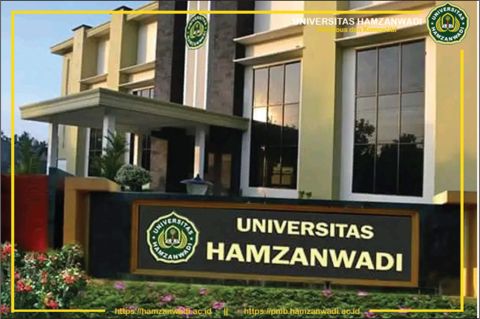
Source: Hamzanwadi Team.
The five strategic programs of the regional government ‘NTB Gemilang’ are contained in the vision and mission of the Regional Medium Term Development Plan of the NTB Provincial Government, namely, superior tourism, industrialisation, developing human resource competitiveness, investment-friendly NTB, developing regional connectivity and accessibility, as well as a clean and sustainable NTB (Results of a semi-structured interview with the Deputy Governor of NTB 2022). In the mainstay tourism sector, there are six programs, namely, development of small island (Gili) tourism, Mandalika Special Economic Zone, development of the Unesco Rinjani Global Geopark, development of the Tambora National Geopark, development of world-class halal tourism, and alleviating poverty with a poverty alleviation approach. community-based tourism (with the formation of 99 tourist villages).
Based on records from the NTB Tourism Office, at least 15,000 tourism sector workers were affected by the COVID-19 pandemic. With details in the hospitality sector 6,150 people, in the tourism awareness group sector 2,421 people, in the travel/guide sector 1,383 people, porters 636 people, homestay 213 people, then the Creative Economy/IKM sector 2,241 people, Art Studio 363 people, Culinary 229 people, 531 Boatmen and 833 cleaners,
The 99 tourist villages program is producing results. The proof is that tourist villages in NTB have won various awards and championships. Of the 25 priority tourist villages for development by the NTB Provincial Government in 2019, a number of villages have received awards from the central government. ‘Among them, the Bilebante Green Tourism Village, Central Lombok Regency, which was selected as the winner of two nature categories in the 2021 BCA Tourism Village Award competition, became a model village that received Tourism Village Certification in 2020 and various other awards’. (Interview with Deputy Governor of NTB)
The Deputy Governor of NTB stated that:
NTB’s economy in the first quarter of 2023 compared to the first quarter of 2022 grew by 3.57%. In terms of production, Construction experienced the highest growth of 12.76%. ‘In terms of expenditure, the PMTB component experienced the highest growth of 6.21%’. For more details see (BPS, 2023)
With the development of the Mandalika circuit with support from the central government, NTB has succeeded in hosting the 2021 World Superbike and 2022 MotoGP. This event has stimulated NTB’s tourism to become lively with skyrocketing tourist visits. The Samota-Sumbawa Motocross World Championship Series succeeded in leaving a good impression in the eyes of the international world, so that he was awarded the MXGP Best Media Opportunity category at the 2022 MXGP Awards in Turkey (2022). MXGP produces money circulating in the NTB area of up to IDR. 154.03 billion with the biggest impact on domestic circulation in the business sector of providing accommodation and food and drink, which reached Rp. 34.99 billion (Farida, 2022).
Figure 10. Mandalika Circuit in Lombok.

Source: Wikipedia (2025).
Another transformation of Lombok society is in the health sector. There are no health facilities with Islamic characteristics for the people of Lombok. The local government collaborated with religious leaders to form an Islamic-based foundation, namely the West Nusa Tenggara Islamic Hospital Foundation (YARSI) and established the Siti Hajar Mataram Islamic Hospital, which is located in the city of Mataram. With the existence of the competency education regulations for nursing staff, YARSI has upgraded education from an academy to a College of Health (STIKES Yarsi Mataram).
Figure 11. STIKES Yarsi Mataram Campus (Photo by Researcher).

Conclusion
The description and form of transformation of rural communities on Lombok Island through education and tourism is taking place very quickly and enthusiastically because all components involved, namely rural communities, universities, provincial government and other stakeholders, are synergising and helping each other non-stop, without stopping. waiting for funds from the central government. Transformation in the education sector can be seen in the physical form of modern schools and modern Islamic boarding schools, while transformation through tourism can be seen in the large number of rural communities involved in tourism activities. These two transformations succeeded in making Lombok society better, and Lombok Island became more widely known to local and foreign tourists while maintaining local wisdom as a religious society, but not a priori towards modernity. The transformation of Lombok society can be an example for communities in other parts of the world.
Acknowledgements
The authors would like to acknowledge all the participants who participated in the study.
Contributor
Retno Ambarwati Sigit Lestari (Universitas 17 Agustus 1945 Semarang).
Fef Rukminingsih & Sri Sutanti (Politeknik Katolik Mangunwijaya Semarang)
Muhsyanur & Baso Syafaruddin (Institut Agama Islam As’adiyah Sengkang)
Endang Lestari (LPP Yogyakarta)
Christy Damayanti, Widiastuti, Setyasih Harini (Universitas Slamet Riyadi Surakarta)
Luky Mudiarti (UNISNU Jepara)
Hadi Riwayati Utami (Universitas PGRI Semarang)
Margiyono Suyitno (STIT MADINA Sragen)
Abdurrahman Sadikin (Universitas Lambung Mangkurat Banjarmasin)
Nur Lailiyah (Universitas Nusantara PGRI Kediri)
Rosa Nikmatul Fajri (Universitas Alma Ata Yogyakarta)
Rabiyatul Adawiyah, Isnaini Yulianita Hafi, Lale Syifa Nufus, Ade Irma FN. Rauhul Akbar Kurniawan, Baiq Salkiah, Lale Yaqutunnafis, & Siti Wahyu Puji Anggraini (Universitas Nahdlatul Wathan Mataram)
Zaitun & Muhammad Adi Junaidi (Universitas Hamzanwadi).
Muhammad Tahir & Murahim (Universitas Mataram).
Murahim (Universitas Mataram).
Declaration of Conflicting Interests
The authors declared no potential conflicts of interest with respect to the research, authorship and/or publication of this article.
Funding
The authors received no financial support for the research, authorship and/or publication of this article.
ORCID iD
Esti Ismawati  https://orcid.org/0000-0002-5236-934X
https://orcid.org/0000-0002-5236-934X
Akama, J. S., & Kieti, D. M. (2007). Tourism and socio-economic development in developing countries: A case study of Mombasa resort in Kenya. Journal of Sustainable Tourism, 15(6), 735–748.
Akib, E. (2020). Overview of tourism in education: Studies towards the era of the industrial revolution. Heirloom. Journal of Tourism, Hospitality, Travel and Events Business, 2(1), 1–8.
Asyári, H., Muhiddin, A., & Rafiuddin. (2015). NW study: Education, social affairs and da’wah. HIMMAH NW Press.
Badan Pusat Statistik Provinsi Nusa Tenggara Barat. (2023). Produk Domestik Regional Bruto Atas Dasar Harga Berlaku Menurut Lapangan Usaha (Seri 2010). Retrieved, 24 April 2025, from https://ntb.bps.go.id/indicator/52/352/1/-seri-2010-pdrb-atas-dasar-harga-berlaku-menrut-field-usaha.html
Binder, M. J., Barrett, E., & Beattie, J. (2022). We do big things from small things: Home employee and volunteer well-being in rural environments. International Journal of Community and Social Development, 3(1), 68–83. https://doi.org/10.1177/2516602621998106
BPS. (2023). Statistik Indonesia. https://www.bps.go.id/id/publication/2023/02/28/18018f9896f09f03580a614b/statistik-indonesia-2023.html
Clifton, J., & Benson, A. M. (2006). Planning for sustainable ecotourism: The case for research ecotourism in developing country destinations. Journal of Sustainable Tourism, 14(3), 238–254.
Creswell, J. W. (2012). Educational research: Planning, conducting, and evaluating qualitative research. University of Nebraska–Lincoln.
Farida, B. (2022). Zul-Rohmi’s 4 year tourism record: Promises, implementation and recommendations. https://lombokpost.jawapos.com/opini/19/09/2022/note-pariwisata-4-tahun-zul-rohmi-promise-implementation-dan-rekomendasi/
Fitri, M. R. (2019). Progress in the implementation of Sustainable Development Goals (SDGs) in Indonesia. www.infid.org
Garci, C. S. (2022). Experiences and hopes of young residents in poor neighborhoods in Central America. International Journal of Community and Social Development. https://doi.org/10.1177/251660262211232343
Hamdi, S. (2018). Integration of culture, education and politics in the da’wah of Nahdlatul Wathan (NW) in Lombok: Biographical study of TGH. Zainuddin Abdul Madjid. Walisongo Journal of Sociology, 2(2), 105–122.
Hamzanwadi. (1998). A period of reflection on new experiences. Hamzanwadi Press.
Hermawan, M. S., & Loo, M. K. (2019). Kinship construction as Indonesian organizational culture. Literature, 31(1). https://doi.org/10.22146/jh.v31i1.4281
Honey, M. (2008). Ecotourism and sustainable development: Who owns paradise? Island Press.
Irawanto, D. W., Ramsey, P. L., & Ryan, J. C. (2011a). The challenges of leading in Javanese culture. Asian Ethnicity, 12(2), 125–139.
Irawanto, D. W., Ramsey, P. L., & Ryan, J. C. (2011b). Adapting leadership theory to Indonesian culture. Global Business Review, 12(3), 355–366.
Ismawati, E. (2016). Language and literature education research methods. Ombak.
Kane, M. J., & Tucker, H. (2004). Adventure tourism: Freedom to play with reality. Tourism Studies, 4(3), 217–234.
Kementerian Agama Republik Indonesia. (2020). Statistik Pondok Pesantren. Direktorat Pendidikan Diniyah dan Pondok Pesantren. Retrieved, April 24, 2025, from https://ditpdpontren.kemenag.go.id/pdpp/statistik?id=52
Kenya Wildlife Service. (2023). Official website.
Lombok Island. (2012, June 21). Lombok International Airport. Traveling to Lombok. https://travelingtolombok.blogspot.com/2012/06/lombok-international-airport.html
Meyers, K. (2009). Understanding tourism. https://drive.google.com/file/d/0B9JtpWUzK cwkOUIwdnRTU045aUE/edit?resourcekey=0-7C2WaUnLHkiuDlF9IbTSZg
Nailufar, N. N. (2020). Weber trail, Wallace trail, and Lydekker trail. https://www.kompas.com/skola/read/2020/03/28/080000469/garis-weber-garis-wallace-dan-garis-lydekker
Noor, M., Habib, M., & Zuhdi, M. H. (2014). Vision of religious nationality: Tuan Guru Kiyai Haji Muhammad Zainuddin Abdul Madjid 1904–1997. Nahdlatul Wathan Islamic Boarding School Jakarta & Al-Quran Printing Institute.
NTB Central Statistics Agency. (2023). NTB economic growth [Economic growth of West Nusa Tenggara]. https://ntb.bps.go.id/pressrelease/2023/05/05/931/ntb--tw1-2023--perkerjaan-bisnis-nusa-tenggara-barat.html
NTB Provincial Government. (2018). Regional medium term development plan (RPJMD), NTB Provincial Government: Five strategic programs. https://ntb.bps.go.id/id/publication/2018/08/16/90d3aad9541199a1fe6f0e97/provinsi-nusa-tenggara-barat-dalam-angka-2018.html
Padabain, F. A., & Nugroho, S. (2018). Implementation of the tourism village program in the context of community empowerment in Mas Village, Ubud District, Gianyar Regency, Bali Province. Journal of Tourism Destinations, 5(2), 145–154..
PBB. (2016). UNWTO Tourism Highlights, 2016 Edition. https://www.unwto.org/archive/global/publication/unwto-tourism-highlights-2016-edition
Prakoso, A. A. (2025). Garis Wallace dan Weber – Pengertian, Sejarah dan Pembagian. RimbaKita.com. https://rimbakita.com/garis-wallace-dan-weber/
Pristiwasa, I. W. T. K. (2021). New opportunities for the tourism sector [New opportunities for the tourism sector]. https://batamnow.com/peluang-baru-dan-pembangunan-berkebesaran-sdgs-sektor-pariwisata/
Ragusa, A. T. (2022). Escaping the city and community fit: Finding ‘place’ in Australia. International Journal of Community and Social Development, 4(1), 61–88. https://doi.org/10.1177/25166026211070374
Republic of Indonesia. (2009). Undang-Undang Pariwisata. https://peraturan.bpk.go.id/Details/38598/uu-no-10-tahun-2009
Rimbakita. (2022). Pesona Lombok [Charm of Lombok]. https://www.bing.com/images/search?q=artikel+tentang+lombok+di+rimba+kita&qpvt=Artikel+tentang+Lombok+di+Rimbakita&form=IGRE&first=1
Ritchie, J. R. B., & Crouch, G. I. (2003). The competitive destination: A sustainable tourism perspective. CABI Publishing.
Royal Government of Bhutan. (2018). Gross National Happiness Commission. https://www.mfa.gov.bt/embassies-missions-and-consulates-abroad/
Selvarajah, C., & Meyer, D. (2017). Human capacity development in Indonesia: Leadership and managerial ideology in organizations in Java. Asia Pacific Business Review, 23(2), 264–289.
Selvarajah, S., Todd, I., Tighe, P. J., John, M., Bolton, C. E., Harrison, T. W., & Fairclough, L. C. (2016). Multiple circulating cytokines are coelevated in chronic obstructive pulmonary disease. Mediators of Inflammation, 3604842. https://doi.org/10.1155/2016/3604842
Sosa-Díaz, M. J., & Valverde-Berrocoso, J. (2022). Grounded theory as an educational technology research methodology. International Journal of Qualitative Methods, 21, 1–13. https://doi.org/10.1177/1609406922113322
Suara NTB. (2022). UNW and 17 universities (ADLPTI) impact on education progress on Lombok Island. https://www.bangunantb.com/2022/09/29/universitas-nahdlatul-wathan-mataram-jalin-kerja-sama-dengan-association-dosen-lintas-perguruan-tinggi-indonesia/
Sunaryo, A., & Yuli, K. W. (2022). The iconic shape of the traditional javanese food Oblok-Oblok. KnE Social Sciences, 465–470. https://doi.org/10.18502/kss.v7i14.11998
Tempo. (2018). Pesona wisata island Lombok. https://national.tempo.co/read/1151655/pesona-wisata-island-lombok
The Bali Tourism Board. (2023). Official website. https://bali.bps.go.id/en/pressrelease/ 2024/01/02/717889
University of Costa Rica. (2023). Official website. https://www.iau-hesd.net/university/university-costa-rica
Wikipedia. (2025, April 24). Sirkuit Internasional Mandalika. https://id.wikipedia.org/wiki/Sirkuit_Internasional_Mandalika
Wulandari, T. (2021). Knowing the differences between the fauna of western and central Indonesia. https://www.detik.com/edu/detikpedia/d-5707726/menkenal-garis-pemisah-fauna-indonesia-timur-dan-tengah